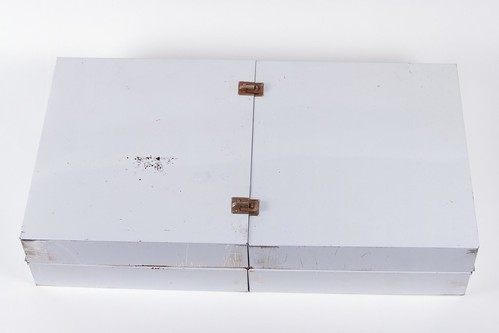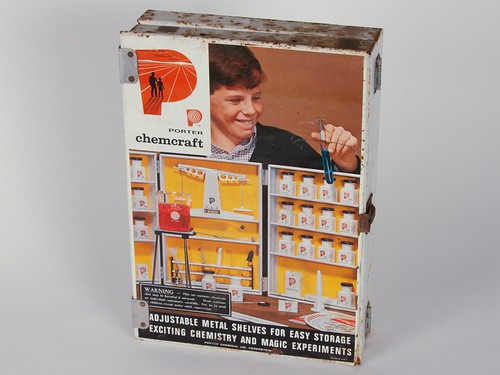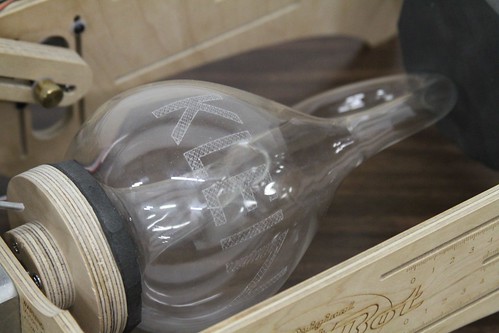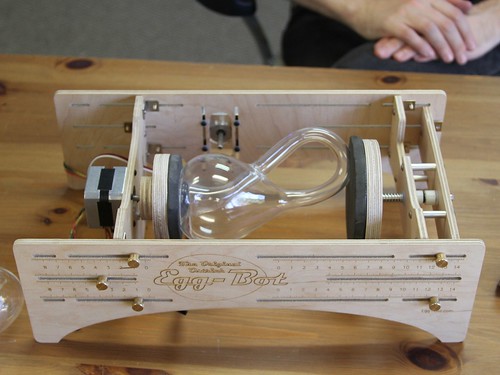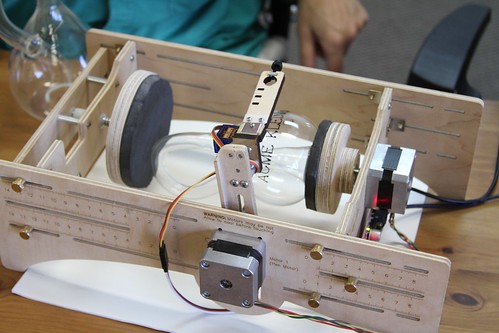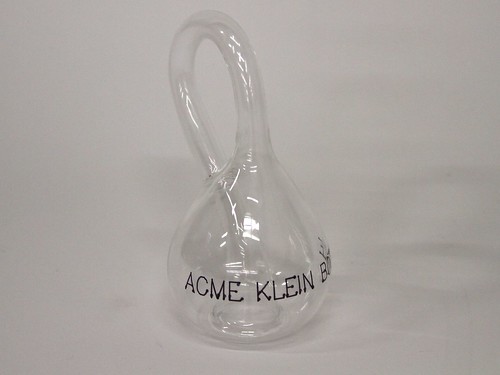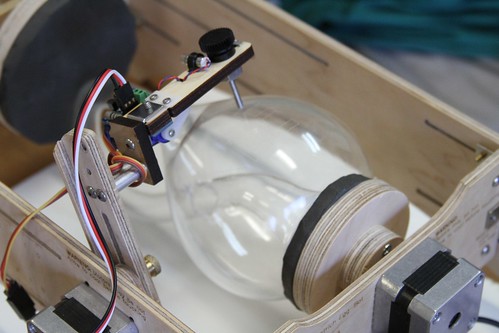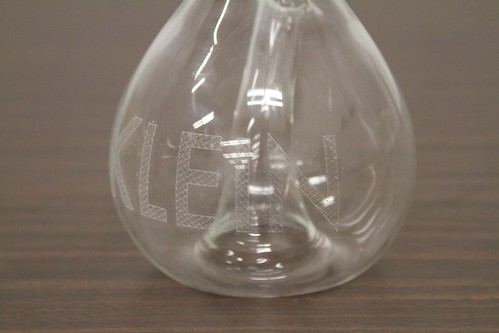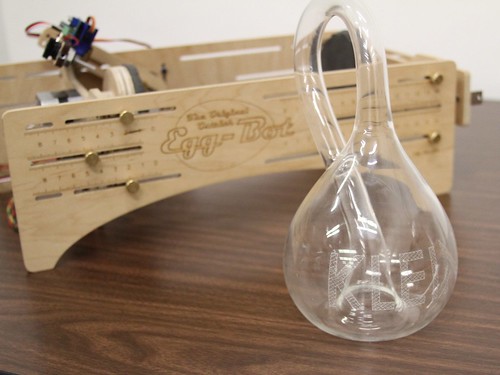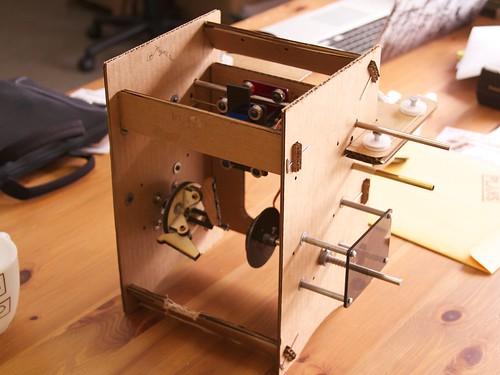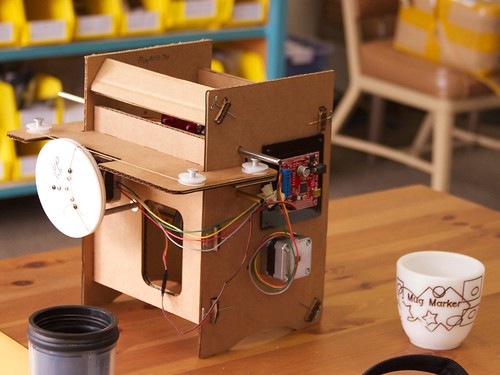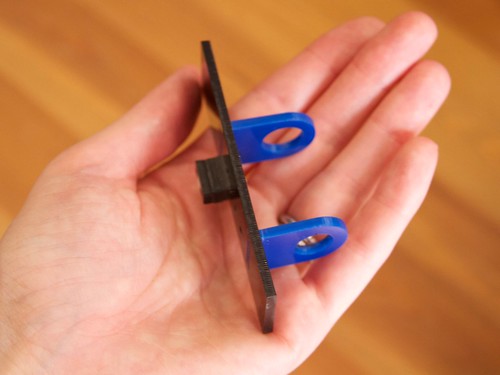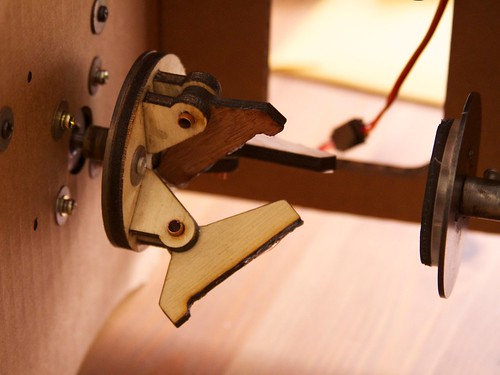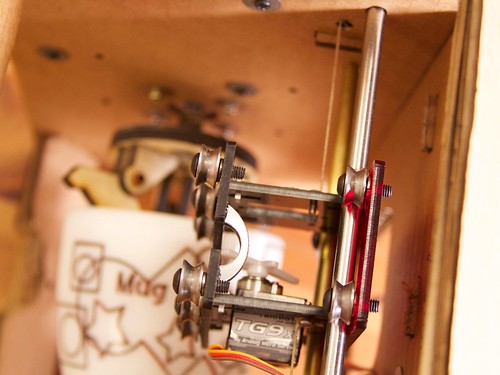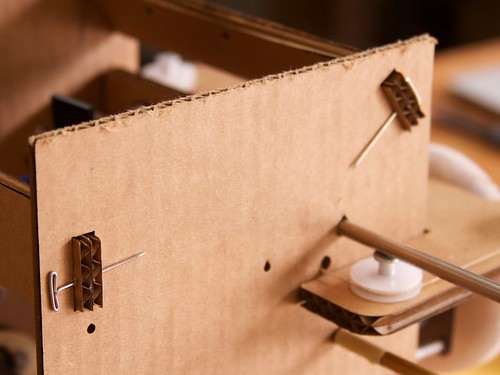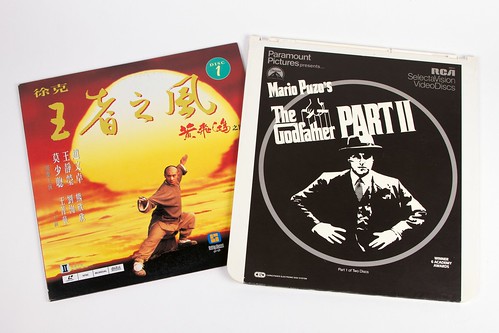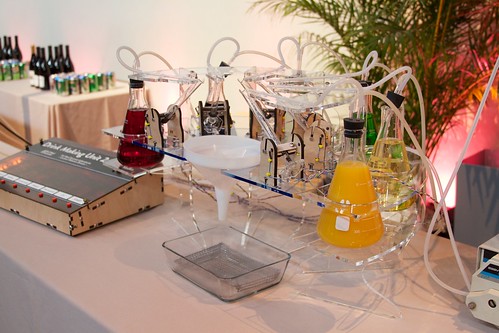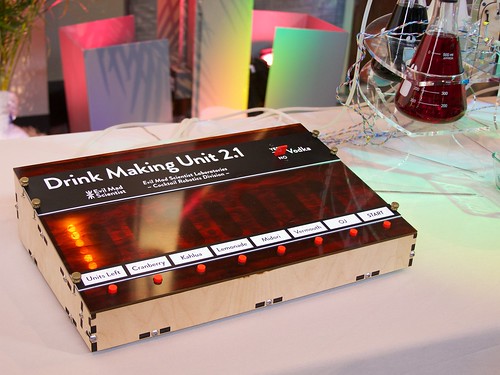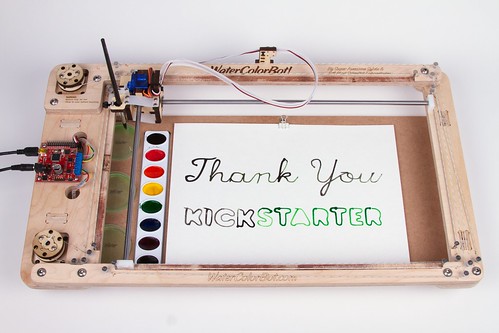A good friend recently presented us with his estate sale find: two 1960’s era vintage chemistry sets. One set is big, white, and mysterious, the other is smaller but showier. Let’s take a look at what’s inside!
Category Archives: EMSL Projects
Marking Klein Bottles with the Eggbot
We were lucky enough to have a visit from Cliff Stoll, geek celebrity and proprietor of Acme Klein Bottle. Acme is the finest source of Klein bottles on the internet.
Cliff came with an esoteric dilemma: how to engrave a glass Klein bottle. Acme Klein bottles are blown from borosilicate (Pyrex) glass, which has a low coefficient of thermal expansion, which means that the usual way of engraving a curved glass surface—laser engraving—doesn’t actually work. With more common types of glass, you can use a laser engraver to etch anything you want into the surface. But with Pyrex, the surface simply melts unevenly rather than creating the microfractures that give an etched appearance.
So how would you etch the curved surface of a Klein bottle? It turns out, to our surprise, that it is remarkably easy to do it with an Ostrich Eggbot fitted with a diamond engraver attachment.
There was one complication, which is that a Klein bottle is a funny shaped object! In order to fixture the Klein bottle in the Eggbot, we made a couple of extra large couplers—much larger than the tiny pads normally used to hold the ends of an egg—with EVA foam rubber pads on their surfaces. The extra large couplers held the Klein bottle securely for rotation.
We did some initial tests with Sharpie and a medium sized Klein bottle to make sure our fixturing worked well.
And then we hooked up an engraver for a real test.
Here’s what the Klein bottle looked like after engraving. Not being particularly creative, we etched the word “KLEIN” into the side. Because the Klein bottle is made from thick borosilicate glass, it takes engraving remarkably well. It is a much more sturdy object than the fragile Christmas ornaments that we have engraved in the past.
While we can’t imagine that it is a major market segment, the Eggbot seems to be ideal for working with Klein bottles (insomuch as anything can be perfect for working with a closed, non-orientable, boundary-free manifold). But regardless, it’s quite wonderful to find an unexpected application like this, where our little robot can solve a real-world problem that we had never even considered.
WaterColorBot at Dorkbot SF, 7/31

Dorkbot SF, the San Francisco chapter of Dorkbot, is having its next meeting tomorrow, July 31. And, we will be bringing along the WaterColorBot for show and tell between the main acts. So if you’re in the area, this would be a great opportunity to come and see the WaterColorBot up close and personal.
Dorkbot is a loosely organized sporadic meeting of people generally interested in “Doing Strange Things with Electricity.” The event will be at Otherlab starting at 7:30 pm. You may know Otherlab from their wonderful Othermill recently launched on Kickstarter. Anyone can attend and admission is free, although there is a suggested donation.
The Mug Marker
Don McRae recently stopped by our shop last week to show off his homebrew CNC project, the “Mug Marker” — a wonderful little cardboard robot that can draw on mugs.
Much like the Mug Plotter on Instructables, it uses the same EBB controller board and stepper motors as the Eggbot, but with linear motion for the pen instead of rotation. However, unlike that version, Don has incorporated the same winch-drive mechanism that we use on the WaterColorBot to provide motion for the linear axis– meaning that it can go fast or slow, with very good accuracy.
Don laser cut the large white winch on the back of the machine from acrylic. It controls a string that pulls the pen carriage back and forth as it rides on a pair of rods:
The pen holder itself slides into some additional bearings, and has a small protrusion on the back that rests on the servo horn, allowing it to be lifted up or lowered down. Like the Eggbot’s pen-lift mechanism, this mechanism only (actively) lifts the pen, which means that it can ride over uneven surfaces, or plot on mugs with variable diameter.
Underneath the pen carriage, the opening of the mug fits onto a three-jaw coupler on the motor shaft, and the base of the mug is held against a rubber faced spring loaded plunger. Small copper tubes are used as bushings to allow the coupler pieces to rotate inward or outward to allow mugs of differing diameters to fit on. A little silicone on the surface of each of the three parts provides a gripping surface, and the upcurved lip keeps the mug from sliding too far.
Looking down through the pen carriage, you can see the mug below held in the coupler.
The chassis of the machine is made from cardboard, either hand or laser cut to slot together, and held together very cleverly with pins. The whole machine is put together from a combination of off the shelf parts and found materials, many of which are laser cut for the correct shape. For software, Don uses the Eggbot Inkscape extensions with very reproducible results.
Thanks to Don for bringing it by and letting us take pictures!
Vintage Technology: Laser and Video Discs
OMG—Is that Once Upon a Time in China IV?
Well, yes, but that’s not what we’re here to talk about. We’ve dug up specimens of two very different types of high-tech video playback media from decades ago— and it’s much more interesting than you might guess. Continue reading Vintage Technology: Laser and Video Discs
Eggers using Eggbots

One of our favorite things about the Eggbot is that we get to connect to the communities that embrace it and find new uses for it. One such group is (not surprisingly) egg artists. They affectionately call themselves “eggers” and are, more likely than not, members of the International Egg Art Guild. One of their enterprising members, Fran, has been creating patterns for use with the Eggbot and sharing them through the Eggers Eggbot Group on Facebook or on Thingiverse.
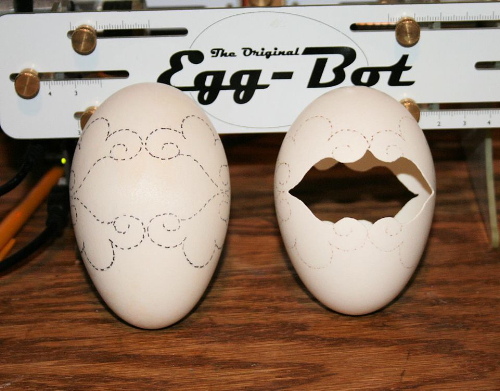
A pattern, after being marked with the Eggbot using a pencil or marker, can be carved, painted, or decorated in a variety of ways. Carving is generally done by hand using a lightweight air powered drill (such as the Turbo Carver).
As with any specialized group of enthusiasts, they have regional shows to display and sell their creations, and to buy and sell the tools of the trade. Fran uses her Eggbot both for marking eggs for her own projects, and for marking eggs to sell at shows for others to finish.

The Eggbot is particularly useful in evenly distributing a repeating pattern around the egg—something that can be difficult to do by hand. The interlocking circles shown on two of the ostrich eggs above were also used to make the egg ornament at the top.
Thank you to Fran for sharing your pictures and projects!
Drink Making Unit 2.1
While we are better known for other types of art robots (like the Eggbot and now the WaterColorBot), we have also been involved with cocktail robotics for the past few years.
After a half-dozen cocktail robotics event over the past couple of years, we’ve had a chance to refit our famous bar-bot, Drink Making Unit 2.0, with a few well-earned upgrades. Read on for the gory details!
WaterColorBot Kickstarter Update #1
Our sincere gratitude goes out to all of our Kickstarter backers and everyone who has helped to spread the word about our WaterColorBot Kickstarter campaign. It has been incredibly rewarding to see each new pledge come in, from friends both old and new. We’re thrilled to announce that we exceeded our funding threshold of $50,000 after just over 60 hours: WaterColorBots are coming!
Today we recorded a little video that you can see on our update page of the WaterColorBot saying (well, painting) “Thank You.” One of the questions we have heard a few times (and have added to our FAQ) has been, “Can the robot go get more paint when it runs dry?” The answer is yes, as you can see in the video.
So is it all in the can and ready to ship? No, not quite yet. You may notice one goof in the video: an unnecessary color change. We’re still sanding away at the rough edges, in order to make sure that everything is ship-shape before we ship.
Thanks for all of the great questions and comments. We’ve already started adding to the FAQ based on your feedback, and we’ll continue to do so as the fantastic questions keep coming in. We’ve already got some excellent suggestions for future software directions, and changes and additions to the API. Getting real feedback from all of you about the different ways that you hope to use the WaterColorBot is immensely helpful in guiding us forward.
We’ve seen the project posted all over the internet, including on Adafruit, Boing Boing, Engadget, Tech Crunch, Gizmodo Germany, and even as far away as Indonesia at Jeruknipis. Many of you have posted it to Twitter and Facebook, and we’re grateful for all of your support.
We had planned to post an update after a couple of days, but we didn’t imagine that we would get to post about surpassing our threshold so soon! We’ll be posting more updates in the near future. There are a lot of interesting details about the WaterColorBot that we haven’t yet written about and are looking forward to sharing with you.
Sylvia on Katie Couric Show
Our collaborator Sylvia went on the Katie Couric show yesterday. She showed off the WaterColorBot and did a couple of science demonstrations with Katie. Her video segments are here and here. Fantastic job, Sylvia!
Introducing The WaterColorBot
Today we’re thrilled to be launching our newest kit: the WaterColorBot.
The WaterColorBot is a brand-new project from Evil Mad Scientist Laboratories and Super Awesome Sylvia — a friendly art robot that moves a paint brush to paint your digital artwork onto paper, using a set of watercolor paints.
We’ve previously written about how we got started on this project (in a guest post by Sylvia), and about Sylvia’s visit to the White House Science Fair, where she was able to give President Obama a personal demonstration of the WaterColorBot.
And now, you can get one too! We’re launching the WaterColorBot today on Kickstarter, and we’d like to ask for your support in getting it out there. The WaterColorBot is an enormously powerful tool for helping to get young people interested in technology:
Beyond simple fun, we think that the WaterColorBot has enormous potential for STEM and STEAM education, especially as a way to get young people engaged with hands-on technology and robotics. We are particularly interested finding ways to inspire young women to pursue careers in science and technology. We cannot imagine any better way to do so, than starting with a robot co-designed by a 12 year old girl.
Perhaps more than anything else that we’ve done, we think that the WaterColorBot really can make the world a better place, one (young) Evil Mad Scientist at a time.




